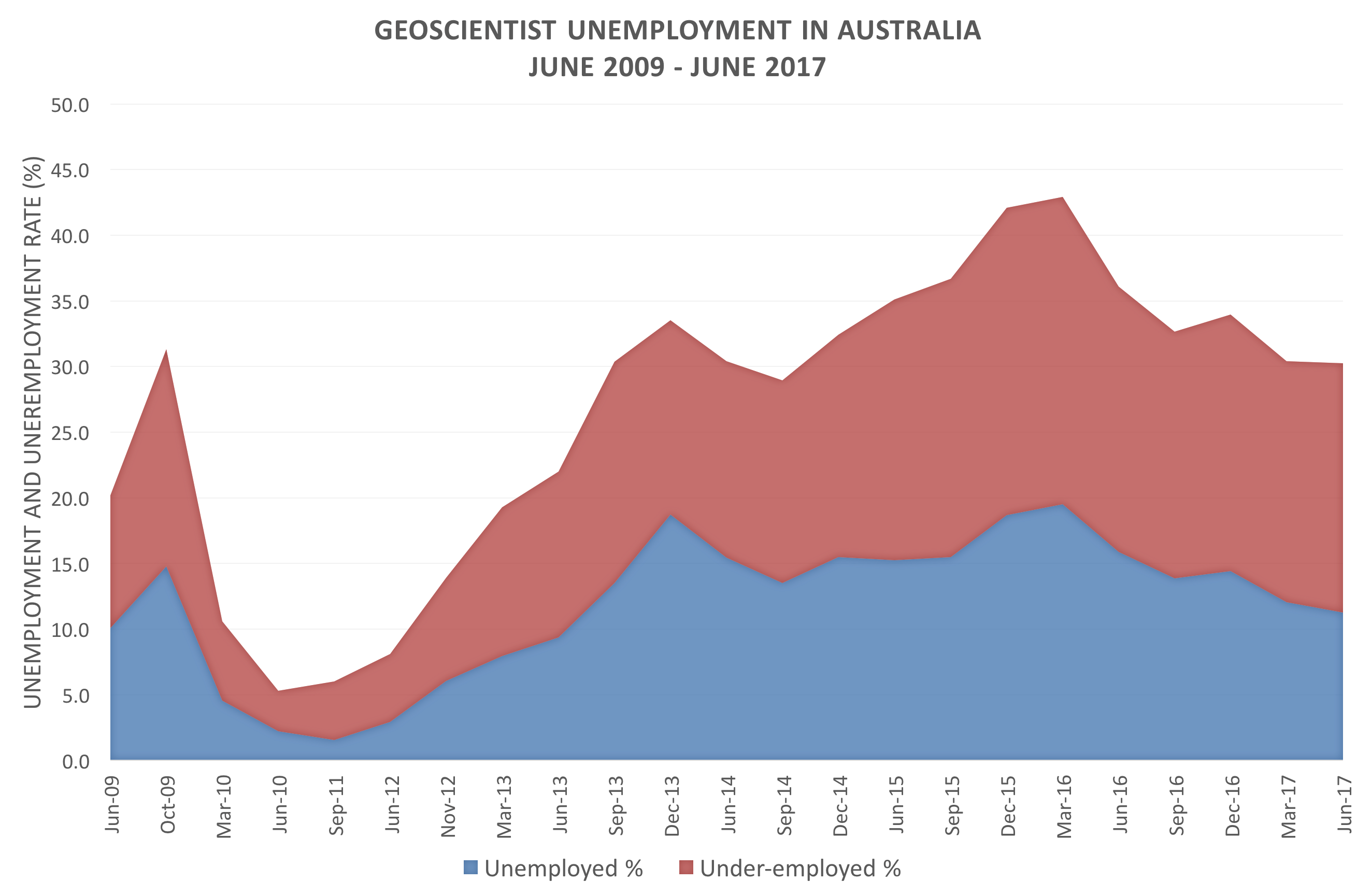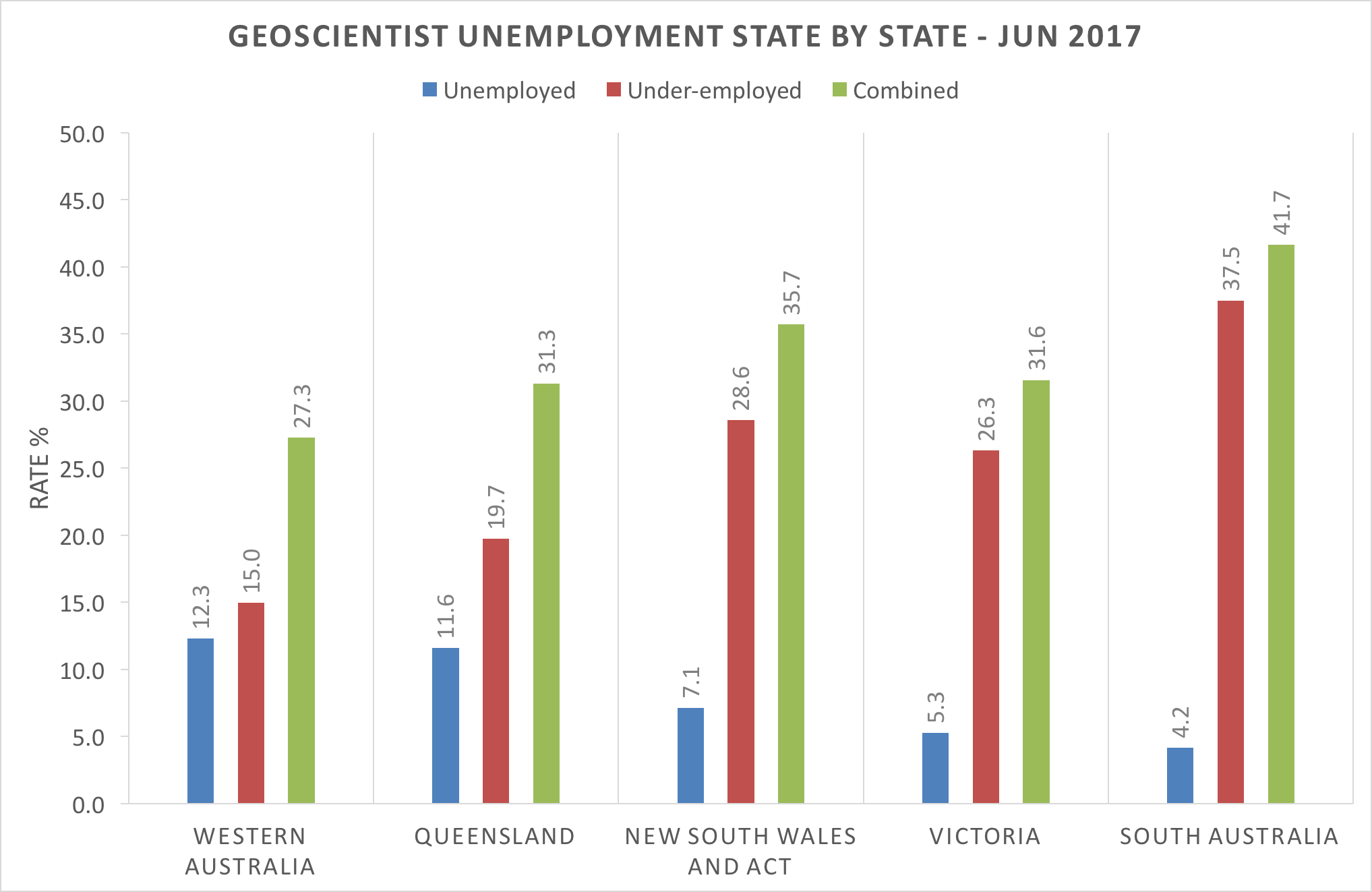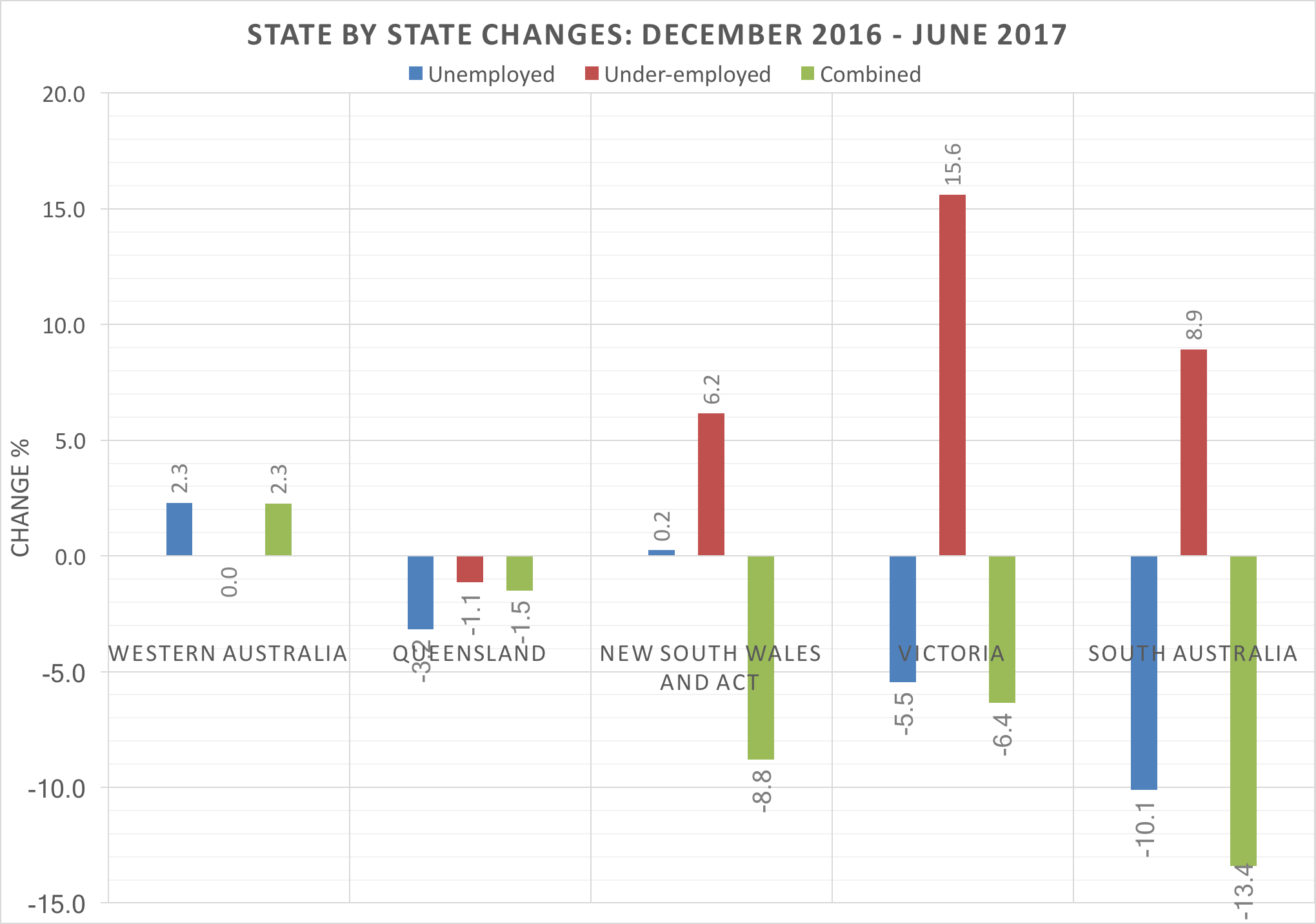Reported significant improvement earlier this year in employment prospects for professionals in Australia’s exploration and mining industry has slowed, according to the latest Australian geoscientist employment survey results collected by the Australian Institute of Geoscientists for the quarter up to the end of June 2017.
During the second quarter of 2017, geoscientist employment across Australia improved marginally compared to the previous quarter. AIG’s latest survey indicates that the unemployment rate amongst Australia’s geoscientists, at 30 June 2017, was 11.3%. The corresponding underemployment rate was 19.0%. This represents a very welcome but small decrease in unemployment, down from 12.1% at the end of March 2017, offset by an increase in the underemployment rate, from 18.3% to 19.0%, during the quarter.

Geoscientist unemployment and under-employment in Australia June 2009 – June 2017
Decreases in the unemployment rate are now evident in four of the past five surveys.
Australia’s self-employed geoscientists, independent contractors and consultants, continue to face difficult times with only half able to secure one quarter of their desired workload.
The employment situation varies markedly between industry sectors. The unemployment in mineral and energy resource exploration in this survey was 14.2%, compared to 6.9% in mineral and energy resource mining and production. The unemployment rate amongst geoscientists working in other fields, such as environmental geoscience, groundwater resource management, engineering geology, education and agriculture, was 4.0%.
Unemployment and underemployment rates varied significantly between states. Unemployment was highest in Western Australia at 12.3%, the only State in which unemployment was observed to increase. South Australia recorded the lowest unemployment rate at 4.2% and the greatest improvement in the unemployment rate during the quarter. Underemployment was lowest in Western Australia, highest in South Australia and worsened in every State except Western Australia and Queensland.

Geoscientist unemployment and underemployment by State

Changes in state unemployment and underemployment during Q2 2016
Long term unemployment decreased but remains a serious concern, with more than 60% of unemployed and underemployed not confident of returning to work within the next 12 months. More than 13% of unemployed geoscientists regained employment during the quarter, but this was more than offset by geoscientists losing employment. Sentiment amongst geoscientists in employment, however, improved, with more than half indicating that they were confident of remaining in employment for the next 12 months or more.
Almost 20% of unemployed and underemployed geoscientists indicated that they were seeking to leave their profession, up 4% from the previous quarter, continuing an increasing trend.
Some 61% of respondents indicated that they were working, or seeking work in mineral exploration. 14% were working or seeking work in metalliferous mining, and almost 8% of respondents were working or seeking work in energy resource exploration, mining and production.
AIG spokesperson, Mr Andrew Waltho, expressed concerns regarding the slow recovery in employment opportunities for geoscientists in Australia, particularly in mineral exploration. “While our latest survey clearly shows that employment prospects for geoscientists are slowly improving generally, with four of the past five surveys recording a decrease in the unemployment rate, exploration activity remains low. “This has serious implications for the sustainability of Australia’s mining industry by threatening the strength of our mineral resource project pipeline. “Both greenfield and brownfield exploration is essential if discoveries are to be made to replace, let alone expand, the resource base on which miners produce essential minerals on which our society and economy relies” he said.
“There are some very positive signs in the latest survey results,” Mr Waltho said. “Unemployment is down, albeit slightly, and employment appears to be strong in the non-mining and resources fields, which represent a small but growing sector in Australian geoscience. “Employment opportunities in mining appear to be improving and while long term unemployment amongst Australian geoscientists remains high, the rate is falling. “It is also encouraging to see that higher rates of unemployment amongst geoscientists with more than 25 years of experience evident in past surveys have come back to levels closer to those for other experience bands.
“The lack of employment opportunities in exploration, however, highlights a serious and growing problem of insufficient exploration being undertaken to sustain our resource industries,” Mr Waltho said. “Geologists and geophysicists are, without doubt, continuously improving exploration technologies and becoming more productive, but this alone won’t make up for a lack of activity – the boots on ground search for new resources.
“Improving access to land, particularly for zero and very low impact exploration activities and addressing areas of sovereign risk that are increasingly being seen by investors as raising the risk profile of exploration, urgently need to be addressed,” Mr Waltho said. “Addressing these two issues throughout Australia has the potential to make an enormous difference in both employment and the future of Australia’s mining industry”.
The Queensland Government’s Collaborative Exploration Initiative (CEI) commenced on 14 August 2017. The initiative provides funding assistance to test high risk or innovative exploration concepts used to understand the geology and prospectivity of under-explored areas.
Funding of $3.6 million has been allocated to the Initiative and is open to existing mineral, petroleum, gas, coal and geothermal explorers working in North West Queensland Mineral Province.
$1.2 million of Round 1 grant funding is now available. Grants offered under the CEI will meet up to half of the direct activity costs, to a maximum of $200,000, for an approved project. An incentive of up to an additional $100,000 applies to Round 1 if the project is completed by 10 August 2018.
CEI builds on funding offered by the previous Collaborative Drilling Initiative (CDI). The new CEI has been expanded to also include both drilling activities and non-drilling activities such as geophysics, geochemistry, and other surveys.
Explorers can now apply for the Collaborative Exploration Initiative in north-west Queensland. Applications for CEI Round 1 must be received by 29 September 2017.
Visit the Queensland Government exploration grants website for more information.
Geoscience Australia is hosting tours of the National Minerals and Fossils Collection and its laboratories and SHRIMP facility Monday to Thursday during National Science Week 13th-19th August 2017.
National Mineral and Fossil Collection: Explore the world class collection of amazing specimens stored in Geoscience Australia’s archive. Numbers limited to 10 per session. Tours will take roughly 1 hour 15 minutes. Not suitable for under 10 year olds. Available times: 10.00am and 6.00pm Monday 14 August, 10.00am and 6.00pm Tuesday 15 August, and 10.00am Wednesday 16 August.
Laboratories and SHRIMP Tour: Ever wanted to study microfossils used by scientists to explore for petroleum and interpret ancient environments? Take a tour through Geoscience Australia’s Laboratories and Sensitive High-Resolution Ion Microprobe (SHRIMP) laboratory. Numbers limited to 20 per session. Tour will take roughly 60 minutes. Available times: 12.30pm Tuesday 15 August and 12.30pm Thursday 17 August.
Tours leave from the Geoscience Australia reception. Bookings are essential and the tours are free of charge. Click here for details.
Click on the banner image or here to visit the National Science Week website for details events across Australia.


Resources for Future Generations 2018 (RFG2018) will showcase advances in earth science, societal and technical innovation, and education that can change the course of history.
Anchored in six themes — Energy, Minerals, Water, the Earth, Education & Knowledge, Communities & Resources — RFG2018 will showcase advances in earth sciences, education, and innovation that can change the course of history.
Present your work to an international cohort of scientists, policy-makers, innovators, educators, industry leaders, and visionaries who are committed to creating a sustainable future.
Be part of the sustainable future. Submit an abstract. Abstracts will be accepted until January 15, 2018.
AIG is a partner organization for this conference.
Applications for this year’s program close on Friday 4th August. Application guidelines are available here.
The Australian Institute of Geoscientists’ Student Bursary Program was initiated to promote and support geoscience research and education in Australia. The Bursary Program began in 2001 to mark the 20th Anniversary of the Australian Institute of Geoscientists (AIG) and, since then, the AIG has awarded 173 bursaries to geoscience students in Australian universities. In 2017 the AIG is again offering bursaries to Honours, Postgraduate and Third Year geoscience students.
Applicants must be current and financial Fellows, Members, Graduate Members or Student Members of the AIG at the closing date for applications.
The AIG Bursary awards are generally announced and awarded in early- to mid-October each year. Applicants seeking funding for specific activities should ensure that the timing of these activities is appropriate to this schedule.
The bursaries are funded via the AIG Education Foundation. This is a charitable foundation and, under Australian taxation legislation, awards can only be made to Australian citizens or permanent residents.
Chris Bonwick – Independence Group
Geoff Davis – Medusa Mining
Macquarie Arc Conference – GSNSW
SMEDG
AIG NSW Branch
AIG State Branches
Alexander Research
Gnomic Exploration Services
Terra Search
Doug Young
ExploreGeo
|
RECIPIENT |
UNIVERSITY | RESEARCH PROJECT |
BURSARY AWARD |
| Katherine Gioseffi | QUT | Testing new in-situ methods for probing microstructural and chemical changes in carbonates under geological loading conditions: insights from X-Ray and Neutron Scattering | AIG Postgraduate |
| Shawn Hood | UTAS | Interpreting structural and geochemical patterns at various scales using machine learning | AIG – SMEDG Postgraduate |
| Charmaine McGregor | UWA | New ID-TIMS U-Pb geochronology of the Tayatea dyke swarm of Australia – identifying Tasmania’s nearest neighbours in the Neoproterozoic | AIG Postgraduate |
| Ahmad Saleem | UWA | Quantifying the role of exploration upside in mineral project evaluations: a missing link in project value determinations? | AIG – Alexander Research Postgraduate Bursary |
| Shaun Anderson | QUT | Probing the crust, I-type to A-type transitions: Sources and relationships of granitoids at Cape Upstart, Northeast QLD | AIG Honours |
| Tegan Beveridge | JCU | Analysis of Campanian Aged Volcanic Ashes in the Fossil Bearing Strata of North America to Determine Age and Origin |
AIG Honours |
| Jessica Godfrey | UWA | The origin of red pigment in Late Devonian limestones and significance for environmental changes, northern Canning Basin | AIG Honours |
| Hugh Merrett | Adelaide | A magnetotelluric study across south-western Victoria constraining a Cambrian subduction system and conductive mantle below Central Victoria | AIG Honours |
| Tristan Wells | UTAS | Genesis of the two-thirty breccia-hosted Cu-Au-Mo prospect, Northparkes, NSW | AIG – Macquarie Arc Conference-GSNSW Honours |
| Rebeca D’Arcy | Macquarie | – | AIG Third Yr |
| Matthew Elsley | UNE | – | AIG Third Yr |
| Kireyeong Lee | Adelaide | – | AIG Third Yr |
| Mitchell Simpson | UQ | – | AIG Third Yr |
| Julia Elise Thornton | Federation | – | AIG Third Yr |
| Georgia Wulf-Rhodes | UTAS | – | AIG Third Yr |
| Marko Zegarac | Curtin | – | AIG Third Yr |
The AIG Education Foundation has been established to help fund the Institute’s education activities. The foundation has been granted deductible gift recipient status by the Australian Taxation Office, ensuring contributions to the foundation by Australian residents and companies are tax deductible. Information on how to contribute to the foundation is available from the AIG Secretariat office.